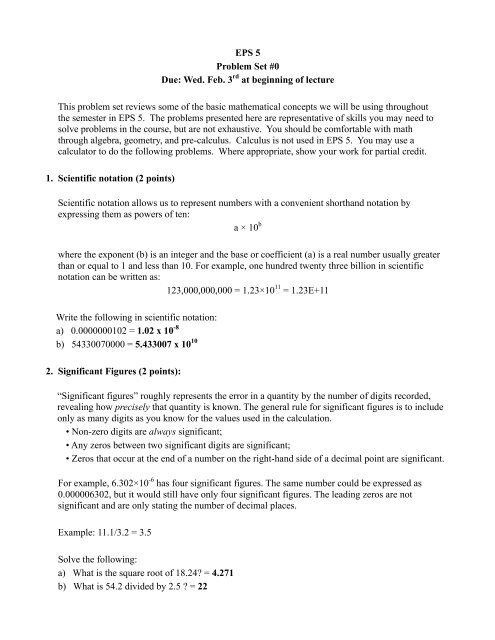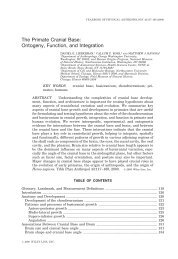EPS 5 Problem Set #0 Due: Wed. Feb. 3rd at beginning of lecture ...
EPS 5 Problem Set #0 Due: Wed. Feb. 3rd at beginning of lecture ...
EPS 5 Problem Set #0 Due: Wed. Feb. 3rd at beginning of lecture ...
You also want an ePaper? Increase the reach of your titles
YUMPU automatically turns print PDFs into web optimized ePapers that Google loves.
<strong>EPS</strong> 5<br />
<strong>Problem</strong> <strong>Set</strong> <strong>#0</strong><br />
<strong>Due</strong>: <strong>Wed</strong>. <strong>Feb</strong>. 3 rd <strong>at</strong> <strong>beginning</strong> <strong>of</strong> <strong>lecture</strong><br />
This problem set reviews some <strong>of</strong> the basic m<strong>at</strong>hem<strong>at</strong>ical concepts we will be using throughout<br />
the semester in <strong>EPS</strong> 5. The problems presented here are represent<strong>at</strong>ive <strong>of</strong> skills you may need to<br />
solve problems in the course, but are not exhaustive. You should be comfortable with m<strong>at</strong>h<br />
through algebra, geometry, and pre-calculus. Calculus is not used in <strong>EPS</strong> 5. You may use a<br />
calcul<strong>at</strong>or to do the following problems. Where appropri<strong>at</strong>e, show your work for partial credit.<br />
1. Scientific not<strong>at</strong>ion (2 points)<br />
Scientific not<strong>at</strong>ion allows us to represent numbers with a convenient shorthand not<strong>at</strong>ion by<br />
expressing them as powers <strong>of</strong> ten:<br />
a × 10 b<br />
where the exponent (b) is an integer and the base or coefficient (a) is a real number usually gre<strong>at</strong>er<br />
than or equal to 1 and less than 10. For example, one hundred twenty three billion in scientific<br />
not<strong>at</strong>ion can be written as:<br />
123,000,000,000 = 1.23×10 11 = 1.23E+11<br />
Write the following in scientific not<strong>at</strong>ion:<br />
a) 0.0000000102 = 1.02 x 10 -8<br />
b) 54330070000 = 5.433007 x 10 10<br />
2. Significant Figures (2 points):<br />
“Significant figures” roughly represents the error in a quantity by the number <strong>of</strong> digits recorded,<br />
revealing how precisely th<strong>at</strong> quantity is known. The general rule for significant figures is to include<br />
only as many digits as you know for the values used in the calcul<strong>at</strong>ion.<br />
• Non-zero digits are always significant;<br />
• Any zeros between two significant digits are significant;<br />
• Zeros th<strong>at</strong> occur <strong>at</strong> the end <strong>of</strong> a number on the right-hand side <strong>of</strong> a decimal point are significant.<br />
For example, 6.302×10 -6 has four significant figures. The same number could be expressed as<br />
0.000006302, but it would still have only four significant figures. The leading zeros are not<br />
significant and are only st<strong>at</strong>ing the number <strong>of</strong> decimal places.<br />
Example: 11.1/3.2 = 3.5<br />
Solve the following:<br />
a) Wh<strong>at</strong> is the square root <strong>of</strong> 18.24? = 4.271<br />
b) Wh<strong>at</strong> is 54.2 divided by 2.5 ? = 22
3. Exponents, Exponentials, and Logarithms (3 points):<br />
“log” refers to a logarithm with a base <strong>of</strong> 10, while “ln” is a “n<strong>at</strong>ural logarithm” and has a base <strong>of</strong> e<br />
(e = 2.71828...). All <strong>of</strong> the rules work for either log or ln, but only the ln form is presented here.<br />
Solve the following expressions:<br />
a) (10 -3 )×(2.9×10 10 ) = 2.9 x 10 7<br />
b) log10(10 -5 ) = -5<br />
c) e ln(18) = 18<br />
4. Degrees and Radians (3 points):<br />
ln(e x ) = e ln(x) = x<br />
ln(x a ) = a ln(x)<br />
ln(x)-ln(y) = ln(x/y)<br />
ln(x) + ln(y) = ln(xy)<br />
(x a ) (x b ) = x a+b<br />
(x a ) b = xa b<br />
x 1/2 = square root <strong>of</strong> x<br />
x -a = 1/x a<br />
x 0 = 1<br />
In science (particularly planetary science) we <strong>of</strong>ten deal with angles. We usually use degrees (360 o<br />
for full circle), but may use radians. 2π radians equal 360 o . Be sure to set your calcul<strong>at</strong>or to<br />
DEGREE MODE if you are using degrees and RADIAN MODE if you are using radians. (Review:<br />
http://www.clarku.edu/~djoyce/trig/angle.html)<br />
Solve the following questions (2 significant figures):<br />
a) cos(π/3) = 0.50<br />
b) sin(45 o ) = 0.71<br />
c) tan(3π/4) = -1.0<br />
5. Solving for variables (2 points):<br />
In this class we will <strong>of</strong>ten need to rearrange formulas to solve for a quantity <strong>of</strong> interest.<br />
Solve the following:<br />
a) (3x + 4y) 1/2 = (12/y) ; Solve for x in terms <strong>of</strong> y. x = (48/y 2 ) - (4/3)y<br />
b) x = ln(3y + 2) ; Solve for y in terms <strong>of</strong> x. y = (1/3)(e x - 2)
6. Unit conversions (5 points):<br />
Keeping track <strong>of</strong> your units is VERY important and will aid you in problem solving!<br />
Convert the following:<br />
a) How many m 3 in km 3 ? = 1 x 10 9<br />
b) If an object has a velocity <strong>of</strong> 100 km/h, wh<strong>at</strong> is its velocity in cm/s? 2.78 x 10 3<br />
c) The area <strong>of</strong> my property is 21.3 hectares. Wh<strong>at</strong> is this in km 2 ? 0.213<br />
d) The <strong>at</strong>mospheric pressure in Cambridge today is 0.981 <strong>at</strong>m. Wh<strong>at</strong> is the pressure in pascal?<br />
9.94 x 10 4<br />
e) The temper<strong>at</strong>ure in Cambridge today is 6 o C. Wh<strong>at</strong> is the temper<strong>at</strong>ure in o F? 43 o<br />
7. Area <strong>of</strong> continents and sea level rise (5 points):<br />
The average radius <strong>of</strong> Earth is 6.38×10 6 m and the combined volume <strong>of</strong> ice in the Antarctic and<br />
Greenland ice caps is 30.2×10 6 km 3 . Continents cover 29.2% <strong>of</strong> Earth’s surface.<br />
Solve the following:<br />
a) Wh<strong>at</strong> is the surface area <strong>of</strong> the earth in km 2 ? 5.12 x 10 8<br />
b) Wh<strong>at</strong> is the total area <strong>of</strong> the continents in km 2 ? 1.49 x 10 8<br />
c) Wh<strong>at</strong> is the rise in sea level in meters if all <strong>of</strong> the ice in Greenland and the Antarctic were to melt?<br />
Assume the total area <strong>of</strong> continents does not change. (Note: a given mass <strong>of</strong> w<strong>at</strong>er occupies 92.0%<br />
the volume <strong>of</strong> the same mass <strong>of</strong> ice) (3 points) 76.8 m
















